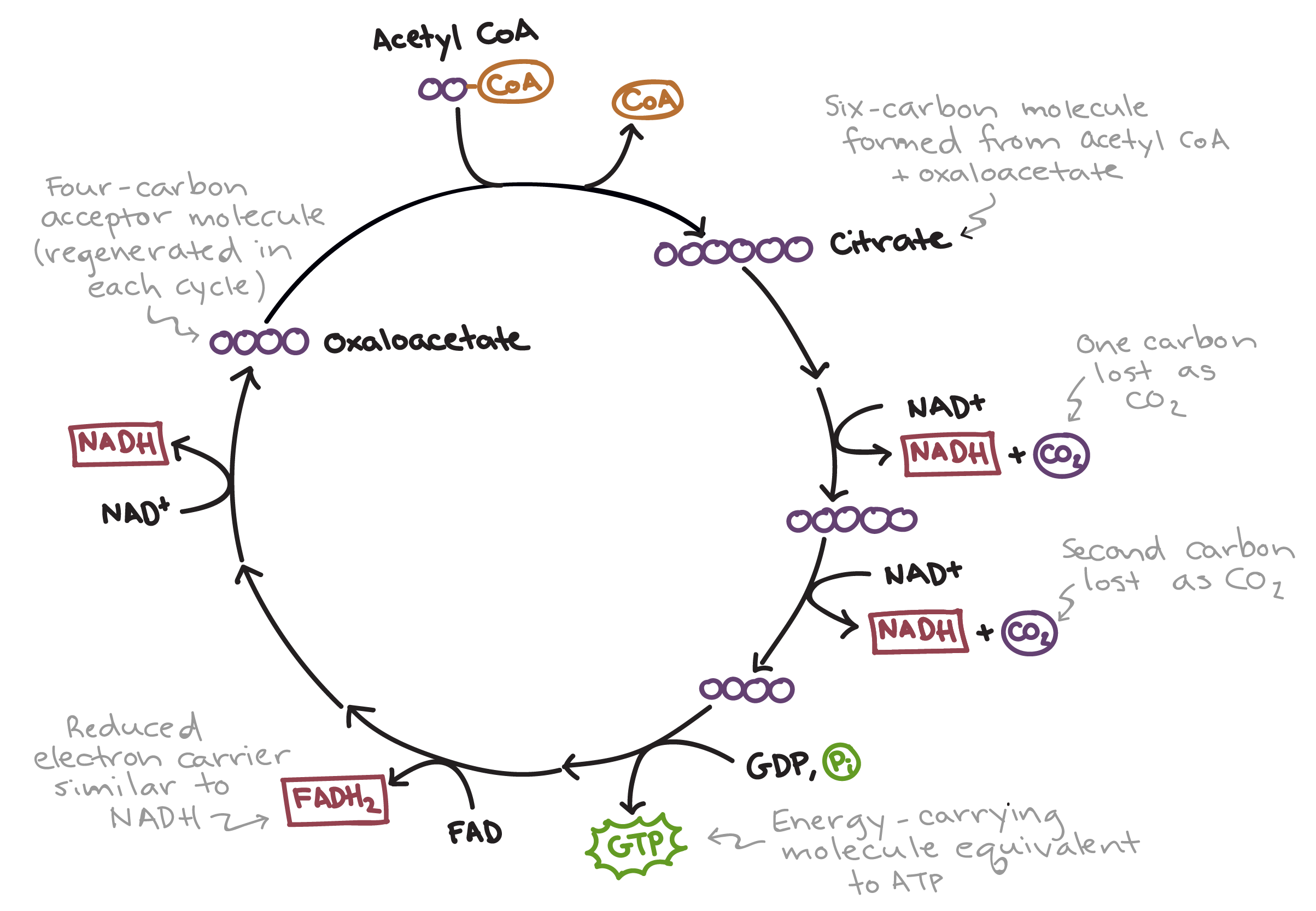Describe What Happens During the Krebs Cycle
In the first step of the Krebs cycle acetyl CoA is added to oxaloacetate to form citrate. The Krebs Cycle also called the citric acid cycle is the second major step in oxidative phosphorylation.
During this step one water molecule is removed and another water molecule is added.

. This process occurs for both pyruvates. It is the respiratory cycle that is. In the first step of the citric acid cycle acetyl joins with a four-carbon molecule oxaloacetate releasing the group and forming a six-carbon molecule called citrate.
Note that coenzyme A CoA-SH is removed in the process. Pyruvic acid is broken down into carbon dioxide. 2 high-energy electrons are passed to NAD to produce NADH.
Adding oxygen to the link reaction or pyruvate oxidation allows the aerobic respiration process to continue. Pyruvate is transported into the mitochondria and loses carbon dioxide to form acetyl-CoA a 2-carbon molecule. Instead this cycle produces NADH and FADH 2 which feed into the respiratory cycle also located inside of the mitochondria.
The Acetic Acid is joined to a compound called Coenzyme A. Citrate is isomerized forming isocitrate which is less stable than citrate. Significance of Krebs Cycle.
2 x CO2 molecules waste product. Its purpose is to collect high-energy electrons for use in the electron transport chain reactions. Acetyl CoA delivers an acetyl group to the Krebs cycle 2.
The citric acid cycle or Krebs cycle is a series of chemical reactions used by all aerobic organisms to generate energy through the oxidization of acetatederived from carbohydrates fats and proteinsinto carbon dioxide. Up to 24 cash back The Acetyl-CoA enters the Krebs Cycle. Reviewing the whole process the Krebs cycle primarily transforms the acetyl group and water into carbon dioxide and energized forms of the other reactants.
The Citric Acid Cycle. Krebs Cycel is a series of 9 enzyme controlled reactions that breakdown Acetyl CoA into CO 2. If no oxygen comes in link reaction fermentation occurs.
Also known as the Citric Acid cycle it was discovered in 1937 by Hans Krebs. The 2 carbon acetyl group combines with the four-carbon oxaloacetate to form six carbon citrate 3. In addition the cycle provides precursors including certain amino acids as well as the reducing agent NADH that is used in numerous.
During the Krebs cyclepyruvic acid is broken down into carbon dioxide in a series of energy-extracting reactions. The Krebs cycle occurs in the mitochondrial matrix and generates a pool of. The 2C Acetyl molecule is broken down into.
Krebs cycle was named after Hans Krebs who postulated the detailed cycle. Then the 2 carbons from Acetyl-CoA are added to a 4 carbon molecule that is already present in the cycle producing a 6 carbon molecule called Citric Acid. The Krebs Cycle completes the breaking down and oxidation of glucose to carbon dioxide.
While the Krebs cycle does produce carbon dioxide this cycle does not produce significant chemical energy in the form of adenosine triphosphate ATP directly and this reaction sequence does not require any oxygen. The citrate molecule undergoes decarboxylation and dehydrogenation producing 1 reduced NAD and carbon dioxide 4. Krebs cycle is the.
In plants and animals eukaryotes these reactions take place in the matrix of the mitochondria of the cell as part of cellular respiration. The Krebs cycle or Citric acid cycle is a series of enzyme-catalyzed reactions occurring in the mitochondrial matrix where acetyl-CoA is oxidized to form carbon dioxide and coenzymes are reduced which generate ATP in the electron transport chain. Also during the Krebs cycle the two carbon atoms of acetyl-CoA are released and each forms a carbon dioxide molecule.
Thus for each acetyl-CoA entering the cycle two carbon dioxide molecules are formed. The Krebs cycle also called the citric acid cycle or tricarboxylic cycle is the first step of aerobic respiration in eukaryotic cells. In the second step citrate is converted into its isomer isocitrate.
The Krebs cycle occurs in the mitochondrial matrix. The resulting molecule is called Acetyl-CoA then enters the Krebs Cycle. 2nd stage of CR.
Krebs Cycle occurs in the mitochondrial matrix. Krebs cycle was named after Hans Krebs who postulated the detailed cycle. After glycolysis breaks glucose into smaller 3-carbon molecules the Krebs cycle transfers the energy from these molecules to electron carriers which will be used in the electron transport chain to produce ATP.
What happens during the Krebs cycle. The Krebs Cycle Step 1. Two acetyl-CoA molecules enter the cycle and each has two carbon atoms so four carbon dioxide molecules will form.
The Krebs cycle occurs on the mitochondrial matrix and generates a pool of chemical energy from the oxidation of pyruvate the end product of glycolysis. Intermediate compounds formed during Krebs cycle are used for the synthesis of biomolecules like amino acids nucleotides chlorophyll cytochromes and fats etc. The Krebs cycle or Citric acid cycle is a series of enzyme catalysed reactions occurring in the mitochondrial matrix where acetyl-CoA is oxidised to form carbon dioxide and coenzymes are reduced which generate ATP in the electron transport chain.
Many bacteria perform the. Describe one or more advantages of producing needed proteins such as insulin through genetic. The citric acid cycle also known as the Krebs cycle or tricarboxylic acid TCA cycle is a series of chemical reactions in the cell that breaks down food molecules into carbon dioxide water and energy.
A 5 carbon molecule is formed 5.

The Citric Acid Cycle Cellular Respiration Article Khan Academy


No comments for "Describe What Happens During the Krebs Cycle"
Post a Comment